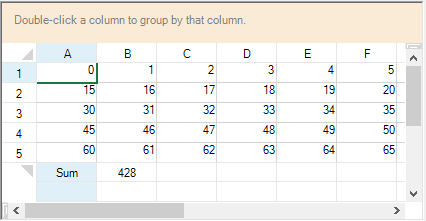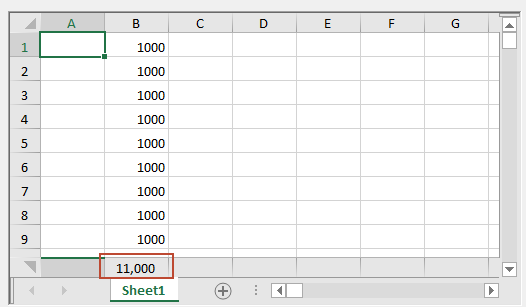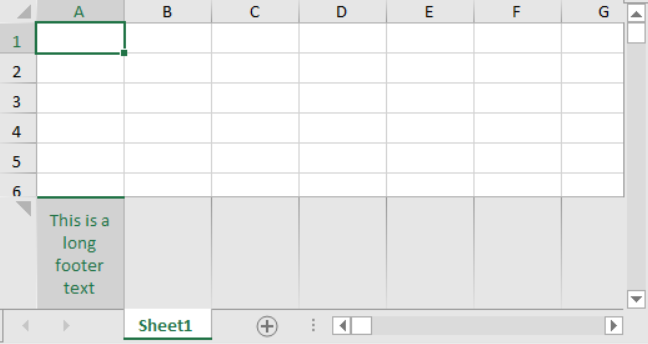-
Spread Windows Forms Product Documentation
- Getting Started
-
Developer's Guide
- Understanding the Product
- Working with the Component
- Spreadsheet Objects
- Ribbon Control
-
Sheets
- Working with the Active Sheet
- Working with Multiple Sheets
- Customizing the Sheet Name Tabs
- Navigating Sheet Tabs
- Adding a Sheet
- Adding ChartSheet
- Removing a Sheet
- Showing or Hiding a Sheet
- Moving a Sheet
- Selecting Multiple Sheets
- Copying and Inserting a Sheet
- Protecting a Worksheet
- Form Controls
- Adding a Title and Subtitle to a Sheet
- Placing Child Controls on a Sheet
- Displaying a Footer for Columns or Groups
- Adding a Tag to a Sheet
- Working with 1-Based Indexing
- Customizing Clipboard Operation Options
- Rows and Columns
- Headers
- Cells
- Cell Types
- Data Binding
- Customizing the Sheet Appearance
- Customizing Interaction in Cells
- Tables
- Understanding the Underlying Models
- Customizing Row or Column Interaction
- Formulas in Cells
- Sparklines
- Keyboard Interaction
- Events from User Actions
- File Operations
- Storing Excel Summary and View
- Printing
- Chart Control
- Customizing Drawing
- Touch Support with the Component
- Spread Designer Guide
- Assembly Reference
- Import and Export Reference
- Version Comparison Reference
Displaying a Footer for Columns or Groups
You can show a column footer, a group footer, or both for the sheet and put information in the footer such as formulas or text. The column footer is an area at the bottom of the sheet. The group footer is an extra row of footer cells at the bottom of a sheet with grouping, if you are using the grouping feature.
For details on the API, refer to the ColumnFooter property of the SheetView class and the various members of the ColumnFooter class.
To calculate the column footer or group footer result with a formula, set the SetAggregationType method of the ColumnFooter object to the correct formula type for that column. The following figure displays a group bar and a column footer with a formula in the column:

The group footer is an extra row that is displayed below the group after grouping by a column header. The GroupFooterVisible property must be set to true after the group has been created. The Grouped event can be used to put information in the group footer after a user has created the group.
For more information on grouping, refer to Managing Grouping of Rows of User Data.
Properties Window
At design time, in the Properties window, select the Sheets property for the FpSpread component.
Click the button to display the SheetView Collection Editor.
Select the ColumnFooter property or the GroupFooter property or both in the Property list and set Visible to true.
Click OK to close the editor.
Using a Shortcut
Set the Visible property of the ColumnFooter for the sheet.
Example
This example code displays a column footer and sets a span and a text color.
C#
fpSpread1.Sheets[0].RowCount = 10;
fpSpread1.Sheets[0].ColumnCount = 15;
// Show the column footer.
fpSpread1.Sheets[0].ColumnFooter.Visible = true;
fpSpread1.Sheets[0].ColumnFooter.RowCount = 2;
fpSpread1.Sheets[0].ColumnFooter.DefaultStyle.ForeColor = Color.Purple;
fpSpread1.Sheets[0].ColumnFooter.Columns[12].HorizontalAlignment = FarPoint.Win.Spread.CellHorizontalAlignment.Left;
fpSpread1.Sheets[0].ColumnFooter.Cells[0, 12].RowSpan = 2;
fpSpread1.Sheets[0].ColumnFooter.Cells[0, 0].Value = "test";VB
fpSpread1.Sheets(0).RowCount = 10
fpSpread1.Sheets(0).ColumnCount = 15
' Show the footer.
fpSpread1.Sheets(0).ColumnFooter.Visible = true
fpSpread1.Sheets(0).ColumnFooter.RowCount = 2
fpSpread1.Sheets(0).ColumnFooter.DefaultStyle.ForeColor = Color.Purple
fpSpread1.Sheets(0).ColumnFooter.Columns(12).HorizontalAlignment = FarPoint.Win.Spread.CellHorizontalAlignment.Left
fpSpread1.Sheets(0).ColumnFooter.Cells(0, 12).RowSpan = 2
fpSpread1.Sheets(0).ColumnFooter.Cells(0, 0).Value = "testMethod to set
Set the Visible property of the ColumnFooter for the sheet.
Set the SetAggregationType method for the column.
Example
This example sums the values in the first column and displays them in the column footer. The example also sums the values in the second group and puts them in the group footer.
C#
private void Form1_Load(object sender, System.EventArgs e)
{
fpSpread1.Sheets[0].RowCount=8;
fpSpread1.Sheets[0].ColumnCount = 15;
fpSpread1.Sheets[0].GroupBarInfo.Visible = true;
fpSpread1.Sheets[0].AllowGroup = true;
fpSpread1.Sheets[0].GroupFooterVisible = true;
fpSpread1.Sheets[0].ColumnFooter.Visible = true;
fpSpread1.Sheets[0].ColumnFooter.RowCount = 2;
fpSpread1.Sheets[0].ColumnFooter.Columns[12].HorizontalAlignment = FarPoint.Win.Spread.CellHorizontalAlignment.Left;
fpSpread1.Sheets[0].ColumnFooter.Cells[0, 12].RowSpan = 2;
//Value
for (int r = 0; r < fpSpread1.Sheets[0].RowCount; r++)
{
for (int j = 0; j < fpSpread1.Sheets[0].ColumnCount; j++)
{
fpSpread1.Sheets[0].Models.Data.SetValue(r, j, j + r * fpSpread1.Sheets[0].ColumnCount);
}
}
int i = 0;
fpSpread1.Sheets[0].ColumnFooter.SetAggregationType(0,1, FarPoint.Win.Spread.Model.AggregationType.Sum);
fpSpread1.Sheets[0].ColumnFooter.Cells[0, i].Value = "Sum";
}
private void fpSpread1_Grouped(object sender, EventArgs e)
FarPoint.Win.Spread.Model.GroupDataModel gdm;
gdm = (FarPoint.Win.Spread.Model.GroupDataModel)fpSpread1.ActiveSheet.Models.Data;
gdm.GroupFooterVisible = true;
FarPoint.Win.Spread.Model.Group g1 = (FarPoint.Win.Spread.Model.Group)gdm.Groups[1];
((FarPoint.Win.Spread.Model.IAggregationSupport)g1.GroupFooter.DataModel).SetCellAggregationType(0, 0,
FarPoint.Win.Spread.Model.AggregationType.Sum);
fpSpread1.ActiveSheet.Models.Data = gdm;
}VB
Private Sub Form1_Load(sender As Object, e As EventArgs) Handles MyBase.Load
fpSpread1.Sheets(0).RowCount = 8
fpSpread1.Sheets(0).ColumnCount = 15
fpSpread1.Sheets(0).GroupBarInfo.Visible = True
fpSpread1.Sheets(0).AllowGroup = True
fpSpread1.Sheets(0).GroupFooterVisible = True
fpSpread1.Sheets(0).ColumnFooter.Visible = True
fpSpread1.Sheets(0).ColumnFooter.RowCount = 2
fpSpread1.Sheets(0).ColumnFooter.Columns(12).HorizontalAlignment = FarPoint.Win.Spread.CellHorizontalAlignment.Left
'Value
Dim r As Integer
Dim j As Integer
For r = 0 To fpSpread1.Sheets(0).RowCount
For j = 0 To fpSpread1.Sheets(0).ColumnCount
fpSpread1.Sheets(0).Models.Data.SetValue(r, j, j + r * fpSpread1.Sheets(0).ColumnCount)
Next j
Next r
Dim i As Integer
i = 0
fpSpread1.Sheets(0).ColumnFooter.SetAggregationType(0, 1, FarPoint.Win.Spread.Model.AggregationType.Sum)
fpSpread1.Sheets(0).ColumnFooter.Cells(0, i).Value = "Sum"
End Sub
Private Sub fpSpread1_Grouped(ByVal sender As Object, ByVal e As System.EventArgs) Handles fpSpread1.Grouped
Dim gdm As FarPoint.Win.Spread.Model.GroupDataModel
Dim g1 As FarPoint.Win.Spread.Model.Group
gdm = fpSpread1.Sheets(0).Models.Data
gdm.GroupFooterVisible = True
g1 = gdm.Groups(1)
CType(g1.GroupFooter.DataModel, FarPoint.Win.Spread.Model.IAggregationSupport).SetCellAggregationType(0, 0, FarPoint.Win.Spread.Model.AggregationType.Sum)
fpSpread1.ActiveSheet.Models.Data = gdm
End SubExample
This example code displays a column footer and adds a formula from a different sheet.
C#
fpSpread1.Sheets.Count = 3;
fpSpread1.Sheets[0].RowCount = 8;
fpSpread1.Sheets[0].ColumnCount = 15;
fpSpread1.Sheets[0].GroupBarInfo.Visible = true;
fpSpread1.Sheets[0].AllowGroup = true;
fpSpread1.Sheets[0].GroupFooterVisible = true;
fpSpread1.Sheets[0].ColumnFooter.Visible = true;
fpSpread1.Sheets[0].ColumnFooter.RowCount = 2;
fpSpread1.Sheets[0].ColumnFooter.Columns[12].HorizontalAlignment = FarPoint.Win.Spread.CellHorizontalAlignment.Left;
fpSpread1.Sheets[0].ColumnFooter.Cells[0, 12].RowSpan = 2;
//Value
for (int r = 0; r < fpSpread1.Sheets[0].RowCount; r++)
{
for (int j = 0; j < fpSpread1.Sheets[0].ColumnCount; j++)
{
fpSpread1.Sheets[0].Models.Data.SetValue(r, j, j + r * fpSpread1.Sheets[0].ColumnCount);
}
}
int i = 0;
fpSpread1.Sheets[1].RowCount = 10;
fpSpread1.Sheets[1].ColumnCount = 15;
fpSpread1.Sheets[1].GroupBarInfo.Visible = true;
fpSpread1.Sheets[1].AllowGroup = true;
fpSpread1.Sheets[1].GroupFooterVisible = true;
fpSpread1.Sheets[1].ColumnFooter.Visible = true;
fpSpread1.Sheets[1].ColumnFooter.RowCount = 2;
fpSpread1.Sheets[1].ColumnFooter.Columns[12].HorizontalAlignment = FarPoint.Win.Spread.CellHorizontalAlignment.Left;
fpSpread1.Sheets[1].ColumnFooter.Cells[0, 12].RowSpan = 2;
//Value
for (int r = 0; r < fpSpread1.Sheets[1].RowCount; r++)
{
for (int j = 0; j < fpSpread1.Sheets[1].ColumnCount; j++)
{
fpSpread1.Sheets[1].Models.Data.SetValue(r, j, j + r * fpSpread1.Sheets[1].ColumnCount);
}
}
fpSpread1.Sheets[0].ColumnFooter.Cells[0, i].Value = "2ndSum";
fpSpread1.Sheets[0].ColumnFooter.Cells[0, 1].Formula = "SUM(Sheet2!A:A)";VB
fpSpread1.Sheets.Count = 3
fpSpread1.Sheets(0).RowCount = 8
fpSpread1.Sheets(0).ColumnCount = 15
fpSpread1.Sheets(0).GroupBarInfo.Visible = True
fpSpread1.Sheets(0).AllowGroup = True
fpSpread1.Sheets(0).GroupFooterVisible = True
fpSpread1.Sheets(0).ColumnFooter.Visible = True
fpSpread1.Sheets(0).ColumnFooter.RowCount = 2
fpSpread1.Sheets(0).ColumnFooter.Columns(12).HorizontalAlignment = FarPoint.Win.Spread.CellHorizontalAlignment.Left
'Value
Dim r As Integer
Dim j As Integer
For r = 0 To fpSpread1.Sheets(0).RowCount
For j = 0 To fpSpread1.Sheets(0).ColumnCount
fpSpread1.Sheets(0).Models.Data.SetValue(r, j, j + r * fpSpread1.Sheets(0).ColumnCount)
Next j
Next r
fpSpread1.Sheets(1).RowCount = 10
fpSpread1.Sheets(1).ColumnCount = 15
fpSpread1.Sheets(1).GroupBarInfo.Visible = True
fpSpread1.Sheets(1).AllowGroup = True
fpSpread1.Sheets(1).GroupFooterVisible = True
fpSpread1.Sheets(1).ColumnFooter.Visible = True
fpSpread1.Sheets(1).ColumnFooter.RowCount = 2
fpSpread1.Sheets(1).ColumnFooter.Columns(12).HorizontalAlignment = FarPoint.Win.Spread.CellHorizontalAlignment.Left
fpSpread1.Sheets(1).ColumnFooter.Cells(0, 12).RowSpan = 2
'Value
For r = 0 To fpSpread1.Sheets(1).RowCount
For j = 0 To fpSpread1.Sheets(1).ColumnCount
fpSpread1.Sheets(1).Models.Data.SetValue(r, j, j + r * fpSpread1.Sheets(1).ColumnCount)
Next j
Next r
Dim i As Integer
i = 0
fpSpread1.Sheets(0).ColumnFooter.Cells(0, i).Value = "2ndSum"
fpSpread1.Sheets(0).ColumnFooter.Cells(0, 1).Formula = "SUM(Sheet2!A:A)"Set Column Footer Format
In Spread, you can show the column footer format in flat style using the NumberFormat property of the IRange interface.

For example, you can display a comma as a thousands separator in the footer number format.
C#
// Set flat style in Spread
fpSpread1.LegacyBehaviors = LegacyBehaviors.None;
fpSpread1.Reset();
fpSpread1.Sheets[0].Cells[0, 1, 10, 1].Value = 1000;
fpSpread1.Sheets[0].ColumnFooterVisible = true;
fpSpread1.Sheets[0].ColumnFooterRowCount = 1;
fpSpread1.Sheets[0].ColumnFooter.SetAggregationType(0, 1, FarPoint.Win.Spread.Model.AggregationType.Sum);
// Set number format in column footer
fpSpread1.AsWorkbook().ActiveSheet.ColumnFooter.Cells[0, 1].NumberFormat = "#,##0";VB
' Set flat style in Spread
fpSpread1.LegacyBehaviors = LegacyBehaviors.None
fpSpread1.Reset()
fpSpread1.Sheets(0).Cells(0, 1, 10, 1).Value = 1000
fpSpread1.Sheets(0).ColumnFooterVisible = True
fpSpread1.Sheets(0).ColumnFooterRowCount = 1
fpSpread1.Sheets(0).ColumnFooter.SetAggregationType(0, 1, FarPoint.Win.Spread.Model.AggregationType.Sum)
' Set number format in column footer
fpSpread1.AsWorkbook().ActiveSheet.ColumnFooter.Cells(0, 1).NumberFormat = "#,##0"Wrap Text in Column Footers
You can customize text wrap in a column footer by setting the WrapText property of IRange Interface to true. Note that to view the wrapped text properly in the cell, you need to adjust the row height using the RowHeight property in the ColumnFooter class.
Before applying this WrapText property, ensure that the value of ColumnHeaderRenderer.WordWrap2 property of the SpreadSkin class is set to null. By default, the ColumnHeaderRenderer.WordWrap2 value is null for the default skin only.
The following image depicts a preview of the wrapped text in the column footer.

Use the sample codes below to wrap the column footer text using the IRange.WrapText property.
C#
// Wrap text in column footer
activeSheet.ColumnFooter.Visible = true;
activeSheet.ColumnFooter.Cells.RowHeight = 90;
activeSheet.ColumnFooter.Cells[0, 0].Value = "This is a long footer text";
activeSheet.ColumnFooter.Cells[0, 0].WrapText = true;VB
' Wrap text in column footer
activeSheet.ColumnFooter.Visible = True
activeSheet.ColumnFooter.Cells.RowHeight = 90
activeSheet.ColumnFooter.Cells(0, 0).Value = "This is a long footer text"
activeSheet.ColumnFooter.Cells(0, 0).WrapText = TrueSet Column Style in Group Footer
In Spread, the you can customize the appearance of columns on the group footers using the StyleManager property of FarPoint.Win.Spread.ModelGroupFooter class of the IGroupFooterStyleSupport interface.
You can use the sample codes below to set column style in the group footer using the StyleManager property.
C#
// Set column style in group footer
SheetView STestActiveSheet = fpSpread1.ActiveSheet;
IWorksheet TestActiveSheet = fpSpread1.AsWorkbook().ActiveSheet;
STestActiveSheet.RowCount = 6;
STestActiveSheet.ColumnCount = 4;
STestActiveSheet.Cells[0, 0, 3, 0].Value = 1;
STestActiveSheet.Cells[4, 0, 5, 0].Value = 2;
STestActiveSheet.Cells[0, 2, 3, 2].Value = DateTime.Today;
DefaultGroupFooterCollection defaultGroupFooterCol = new DefaultGroupFooterCollection(6, 4);
DefaultGroupFooter defaultGroupFooter = defaultGroupFooterCol[0];
ISheetDataModel model = defaultGroupFooter.DataModel as ISheetDataModel;
(model as IAggregationSupport).SetCellAggregationType(0, 2, AggregationType.Avg);
fpSpread1.ActiveSheet.DefaultGroupFooter = defaultGroupFooterCol;
GroupDataModel gdm = new GroupDataModel(STestActiveSheet.Models.Data);
STestActiveSheet.Models.Data = gdm;
gdm.Group(new SortInfo[] { new SortInfo(0, true) }, null);
fpSpread1.ActiveSheet.GroupFooterVisible = true;
var style = new StyleInfo();
style.BackColor = System.Drawing.Color.LightBlue;
DateTimeCellType dt = new DateTimeCellType();
dt.DateTimeFormat = DateTimeFormat.UserDefined;
dt.UserDefinedFormat = "dd.MM.yyyy HH:mm:ss";
style.CellType = dt;
style.HorizontalAlignment = CellHorizontalAlignment.Left;
for (int i = 0; i < gdm.Groups.Count; i++)
{
var group = (Group)gdm.Groups[i];
group.GroupFooter.StyleManager.SetColumnStyle(2, style);
}VB
' Set column style in group footer
Dim STestActiveSheet As SheetView = fpSpread1.ActiveSheet
Dim TestActiveSheet As IWorksheet = fpSpread1.AsWorkbook().ActiveSheet
STestActiveSheet.RowCount = 6
STestActiveSheet.ColumnCount = 4
STestActiveSheet.Cells(0, 0, 3, 0).Value = 1
STestActiveSheet.Cells(4, 0, 5, 0).Value = 2
STestActiveSheet.Cells(0, 2, 3, 2).Value = Date.Today
Dim defaultGroupFooterCol As DefaultGroupFooterCollection = New DefaultGroupFooterCollection(6, 4)
Dim defaultGroupFooter As DefaultGroupFooter = defaultGroupFooterCol(0)
Dim model As ISheetDataModel = TryCast(defaultGroupFooter.DataModel, ISheetDataModel)
TryCast(model, IAggregationSupport).SetCellAggregationType(0, 2, AggregationType.Avg)
fpSpread1.ActiveSheet.DefaultGroupFooter = defaultGroupFooterCol
Dim gdm As GroupDataModel = New GroupDataModel(STestActiveSheet.Models.Data)
STestActiveSheet.Models.Data = gdm
gdm.Group(New SortInfo() {New SortInfo(0, True)}, Nothing)
fpSpread1.ActiveSheet.GroupFooterVisible = True
Dim style = New StyleInfo()
style.BackColor = Drawing.Color.LightBlue
Dim dt As DateTimeCellType = New DateTimeCellType()
dt.DateTimeFormat = DateTimeFormat.UserDefined
dt.UserDefinedFormat = "dd.MM.yyyy HH:mm:ss"
style.CellType = dt
style.HorizontalAlignment = CellHorizontalAlignment.Left
For i As Integer = 0 To gdm.Groups.Count - 1
Dim group = CType(gdm.Groups(i), Group)
group.GroupFooter.StyleManager.SetColumnStyle(2, style)
NextThe following image depicts the result of the above code.

Limitation
This feature doesn’t support painting for graphical cell types.
See Also
Managing Grouping of Rows of User Data
Adding a Title and Subtitle to a Sheet


